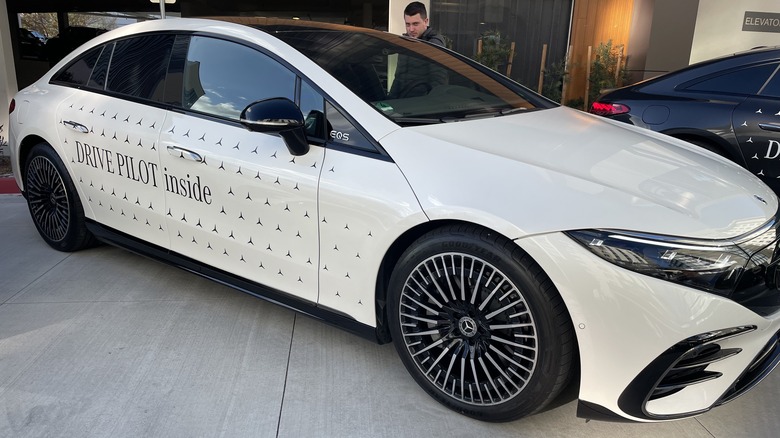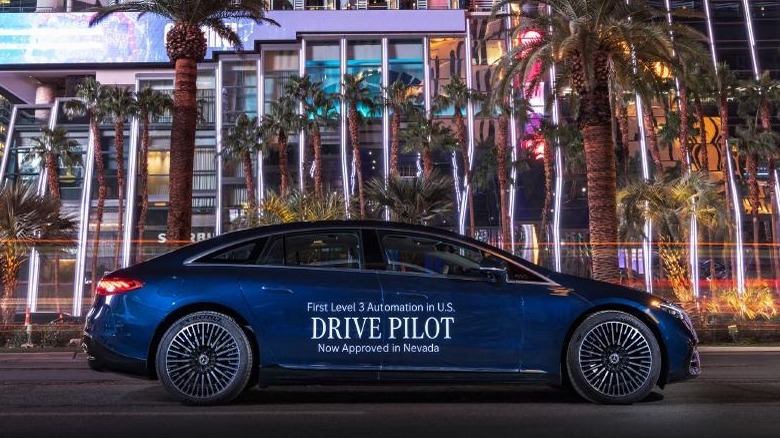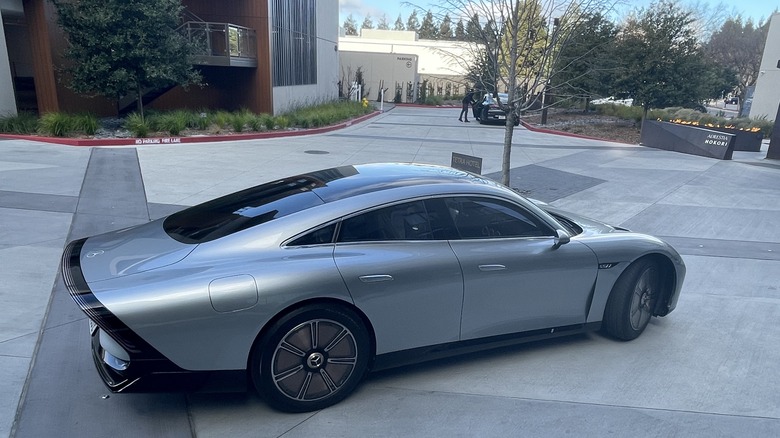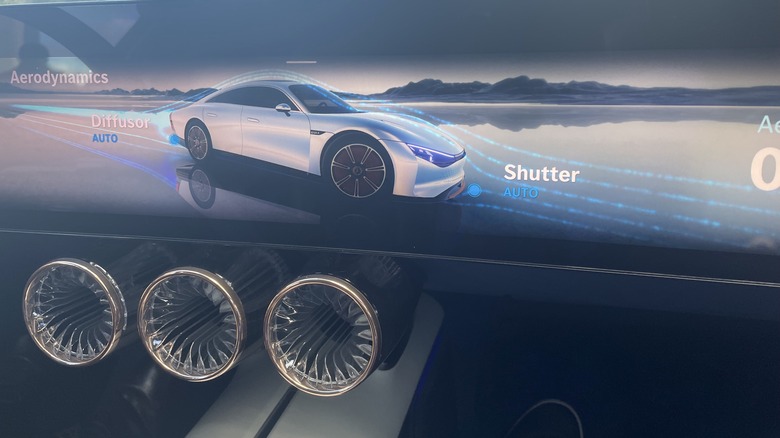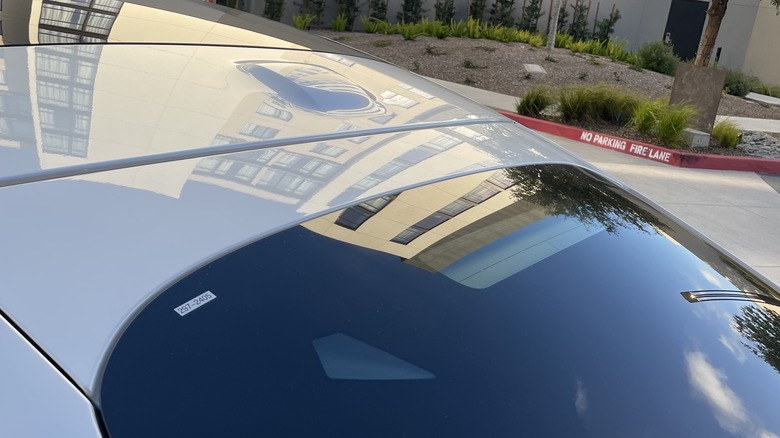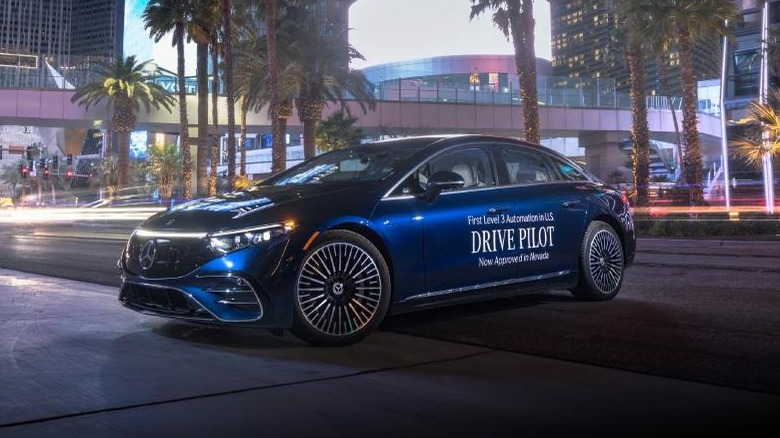We Tried Mercedes' New Self-Driving Tech, And It's Better Than Tesla Full Self-Driving In One Big Way
"There are no autonomous cars on sale today," the honest and accountable automotive writer repeats to themself, while scrolling through clickbait headlines and tweets from Elon stans. "There are no autonomous cars on sale today."
Despite popular misconceptions, there won't be any tomorrow, either, or the next day. But one automaker is much closer than the rest, and it's probably not the one you expect. While certain electric car companies have been reveling in the drama around a "Full Self-Driving" system that is anything but, Mercedes-Benz is close to getting an approved Level 3 system on the road — none of this never-ending "beta" BS.
We recently got the opportunity to experience the Mercedes-Benz Drive Pilot system for the first time on American roads. Already operational in Germany, it's expected to become available on 2024 S-Class and EQS models hitting U.S. dealerships later in 2023. The technology isn't flawless; our preview revealed a few minor hiccups, despite the careful choreography of the demonstrations and the fact that every demo was performed by the automaker's own engineers and product specialists. Still, what we saw of Drive Pilot represents major steps forward in autonomy, whether or not you agree that self-driving cars should be the future. Regardless of where you stand on the issue, it's time to get comfortable with it — or, depending on your perspective, with its inevitability. Here's what we learned during this highly curated experience.
Nevada, where nearly everything is legal
There's a considerable difference between the widely-available Level 2 and semi-autonomous Level 3 "hands-free" driver-assistance systems. Included in the former is the aforementioned Autopilot Full Self-Driving package from Tesla, along with GM's Super Cruise, and Ford's BlueCruise. The GM and Ford systems use terminology such as "compatible roads" and "hands-free zone" to make clear up front that it's not for use everywhere; as of this writing, Tesla is under investigation by the National Highway Traffic Safety Administration and the program has been subject to a recall.
All of which is mentioned to illustrate that this is a touchy topic. In fact, during our time at Mercedes' tech preview at the automaker's Sunnyvale, CA research and development center, rival automakers' systems were hardly mentioned, if at all. Relatively quietly, Mercedes-Benz gained regulatory approval for Drive Pilot to be used on public roads in Nevada at speeds under 40 mph. It's the first Level 3 system to gain such approval in the U.S.
The difference between Level 2 and Level 3 systems is that, with Level 3 — and in the words of numerous Mercedes reps — you can "officially" take your eyes off the road and "do something else." With the Mercedes Drive Pilot system (which is, ostensibly, similar to how rival manufacturers' systems will work, once we get to see them), the Level 3 functions build on the Level 2 functions to take over driving under the correct conditions (currently, at speeds less than 40 mph, based on Nevada's approval), and default to Level 2 when conditions aren't right for Level 3. Currently, Drive Pilot needs a lead car to follow; the system deactivates when there's no car traveling directly ahead at speeds less than 40 mph.
Car as cloister
That means that, as these systems build on each other — Level 2 is, essentially, the result of active safety technology working in harmony — there are scenarios in which it may be difficult for a driver or passenger to tell what's part of a Level 2 system and what's only available when Level 3 is active. It's a learning curve, for sure.
But it's necessary. When the car is operating under Level 2 conditions, the driver is liable in the event of a crash. If a Mercedes-Benz car is the cause of a collision when the car is operating in Level 3, the automaker is ultimately responsible.
So what else can you do, you might ask, while your new Mercedes-Benz is carefully pacing the car in front of you at speeds of 40 mph or less? Reasonable question! You can watch videos (our demo cars were pre-loaded with Mercedes videos showing us what else we could do besides watching videos), play games (our test driver demonstrated a built-in Pong-like game that had to be restarted each time the Level 3 system deactivated due to traffic conditions), stream music or movies, and even take Zoom calls. The driver must stay awake and alert, but otherwise, anything else is fair game, like playing with Mercedes' numerous comfort features, such as a variety of massaging seat functions. If you get bored with the numerous preprogrammed ambient light colors and patterns, you'll soon be able to program your own.
A ride in the Mercedes-Benz Vision EQXX electric concept car demonstrated more practical potential for this downtime: watching the absolutely fascinating displays of the car's real-time energy usagem based on factors such as solar energy capture, wind resistance, and road conditions.
Safety and whatnot
Mercedes-Benz achieved approval for Level 4 parking technology (that is, driverless with no monitoring) in December 2022. Our safety demonstrations, though, showed off both Level 2 and Level 3 capabilities, as well as illustrating how the line between them can get a little fuzzy. Mercedes says most of these Level 2 features, which generally fall under the umbrella of active brake assist technology, have been available on the S-Class since 2020.
For example, take the evasive steering assist feature, which reacts to a sharp input by the driver to help avoid an obstacle. It's a Level 2 feature that must be initiated by the driver to work, although it reacts to the obstacle so quickly and effectively it's almost as if the car was waiting for the driver to notice. It's similar to, but not the same as, active brake assist with cross-traffic alert, and a system that helps the car navigate across an intersection if an obstacle approaches. These systems, Mercedes notes, work up to full highway speed, 70 mph, to avoid a crash or at least help mitigate its effects.
There was a slight hiccup in the demonstration of the Level 2 self-parking system. This system doesn't send the car to a remote spot; it's more to ease it into a tight spot that might prevent occupants from exiting. The driver has to be within six meters of the car with the key (or smartphone app functioning as key) to work, but extremely windy conditions on the day of our demo meant the car and phone had a tough time communicating. On the upside, Mercedes reps pointed out, the phone requires the user to complete a quick test (following a series of dots on the screen) to prevent the system being activated by, say, an errant toddler.
Infrastructure
Mercedes' Level 2 tech uses navigation information, such as the curve of the road, to identify and anticipate automatic turns. This gets particularly cool when, for example, an EV or a car operating in eco mode can use that information to tap kinetic energy through a bend, to avoid wasting power braking and then accelerating.
The Level 3 system is elevated with a sophisticated network of Luminar lidar, an antenna housed in the car's roof bubble, a camera in the rear glass that detects approaching emergency vehicles, and cameras in the wheel wells to evaluate the road surface conditions (for instance, Level 3 would deactivate on wet roads if the car sensed a loss of traction or inaccurate data). Drive Pilot also incorporates redundant energy and braking systems.
These sensors collect up to a terabyte of data per vehicle per hour across the fleet. This information can be used to create new scenarios like weather conditions, human behavior, and new safety hazards, which can then be tested offline before implementing into the system. This data collection is one of the reasons that Mercedes-Benz decided to build its own proprietary operating system.
While Drive Pilot is, as noted, only available at speeds under 40 mph for the foreseeable future, Mercedes-Benz knows this is a limitation that will have to be overcome. It's a mathematical problem, the company notes: when sensors can see more of the road ahead and computers can calculate faster, it'll be safer for cars to travel at higher speeds with time to understand and react to traffic conditions. Mercedes notes that approval for higher speeds will require another round of demonstrations and certifications, and that the goal is to eventually achieve approval for up to 130 km/h globally, or about 80 mph.
Get used to it
Between Drive Pilot and Mercedes-Benz' new proprietary operating system, MB.OS, it's becoming clear that the standard metrics of automotive status like horsepower and torque are becoming less relevant to automakers, at least in terms of these factors' use as a competitive advantage. That's because the goal is not to make these systems merely available, but to make them the default, especially as more advanced autonomous driving and more advanced computer systems help advance the goal of electrification. That said, there's still a ways to go, and no one route that all car companies will take.
"We are not a robotaxi company," clarified Magnus Östberg, Mercedes-Benz' chief software officer.
That said, Mercedes is currently focused on what they consider the "very achievable goal" of Level 3 autonomy, and aren't yet too worried about the challenges of Level 4. The company has been working with U.S. regulators for nearly two years, as the Level 3 system was being developed. Despite the challenges of working state by state and the lack of standardization of such technology, Mercedes is confident that the system will be approved and will be the first Level 3 system available to buyers in the U.S.
